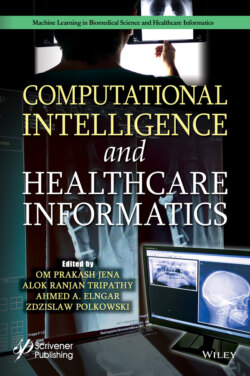Читать книгу Computational Intelligence and Healthcare Informatics - Группа авторов - Страница 40
2.1 Introduction
ОглавлениеIdentification of pathologies from chest x-ray (CXR) images plays a crucial role in planning of threptic strategies for diagnosis of thoracic diseases because thoracic diseases create severe burden on the overall health of a person and ignorance to them may lead to the sudden death of patients. Tuberculosis (TB) continues to remain major health threat worldwide and people continue to fall sick due to TB every year. According to WHO report of 2019 [24], 1.4 million people died due to TB in 2019. When a person suffers with TB, it takes time for symptoms to express prominently. Till then, the infection transfers from person to person results in increase in prevalence of infection and mortality rate. Moreover, Pneumonia is also creating major burden in many countries. Since December 2019, people all over the world were suddenly suffered with Pneumonia with unknown etiology which results in COVID-19 Pandemic. TB, Pneumonia and other disorders are located in the thoracic region are known as thoracic disorders and location of Thoracic pathology is captured through x-ray of thoracic region. There are 14 different classes of thoracic pathologies such as Atelectasis, Pneumonia, Hernia, Edema, Emphysema, Cardiomegaly, Fibrosis, Pneumothorax, Consolidation, Pleural Thickening, Effusion, Infiltration, Nodules, and Mass. CXR is the most preferable screening tool used by radiologist for prediction of abnormalities in thorax region. To understand the exact location and type of pathology, expert radiologists are needed who have enough experience in the field of detecting pathologies from the chest radiology x-ray and are seldom available.
Furthermore, economically less developed countries lack with experienced radiologist and growing air pollution is badly impacting human lungs for which x-ray is the only reasonable tool to detect abnormalities in them. Recent pandemic of COVID-19 motivates researchers to design deep learning models which can predict the impact of SARS CoV-2 virus on human lungs at early stages as well as to identify post COVID effect on lungs. Patients suffering with thoracic abnormalities are associated with major change in their mental, social, and health-related quality of life. For some of them, early chest radiography can save their life and prevent them from undergoing unnecessary exposure to x-rays radiations. Thus, this motivates to explore new findings from it. Therefore, to make accurate prognosis of chest pathologies, researchers have automated the process of localization using Deep Leaning (DL) techniques. These models will act as an assistant to less experienced radiologist with the help of which prediction can be tallied. Due to significant contribution of deep learning in medical field in terms of object detection and classification, researchers have developed many models of DL for classification and localization of thoracic pathologies and compared their efficacy with other models on the basis of various evaluation parameters. This automated system of thoracic pathology detection helps radiologists in faster asses to patients and their prioritization as per the severity.
The overall outline of the chapter is presented as follows: Section 2.2 consists of broad view of existing research employed by various researchers, challenges in detecting thoracic pathology, datasets used by researchers, thoracic pathologies, and parameters used for comparison of models. Section 2.3 details the models implemented by researchers using deep learning and demonstrates the comparison of models on various parameters. Section 2.4 present the conclusion and future directions.
